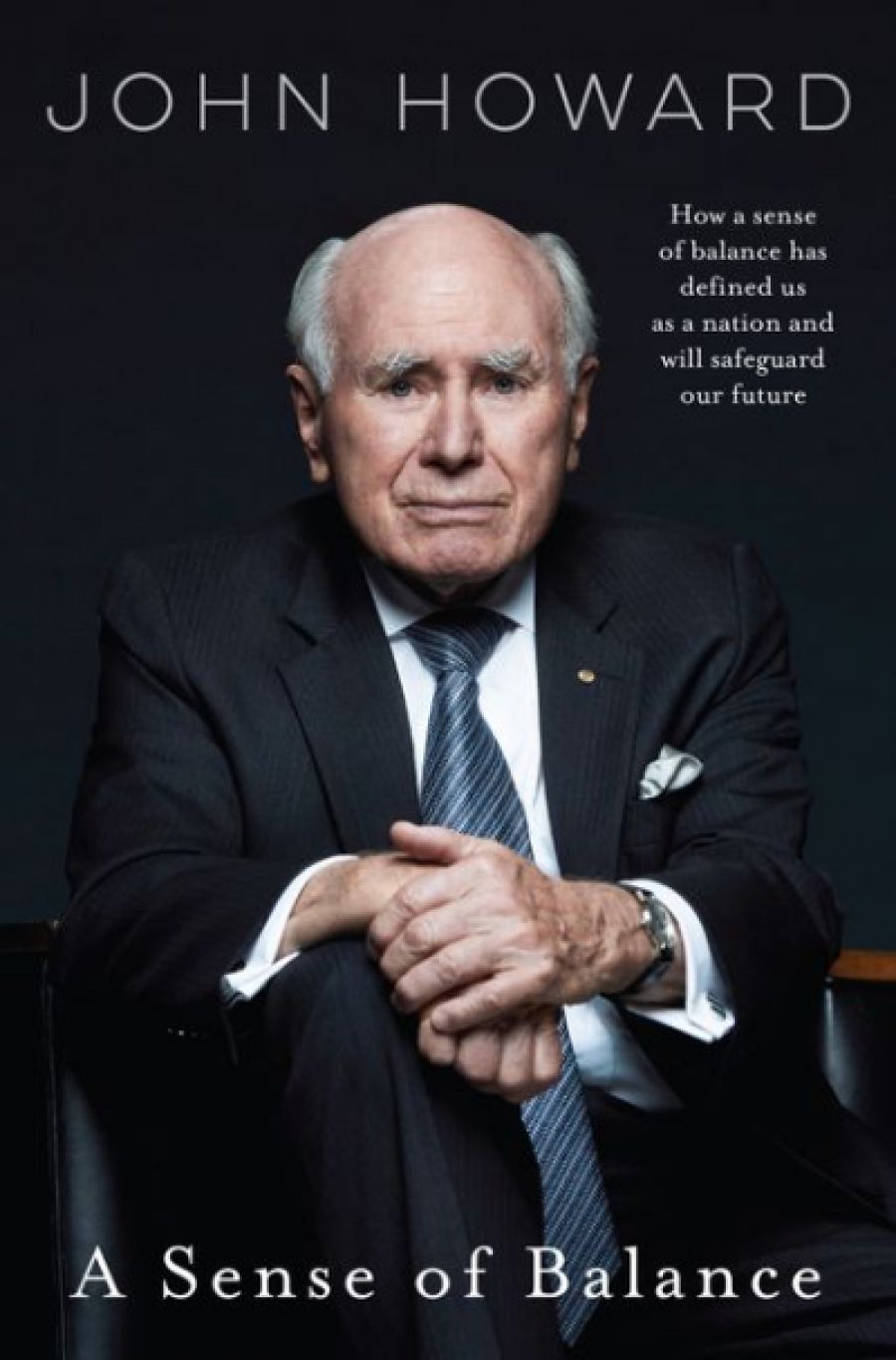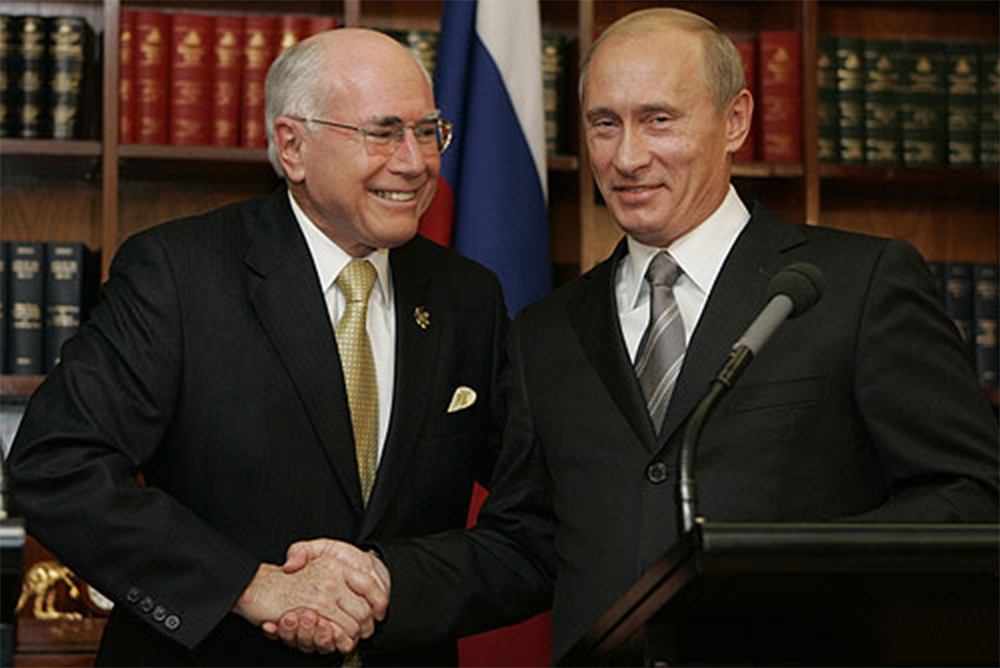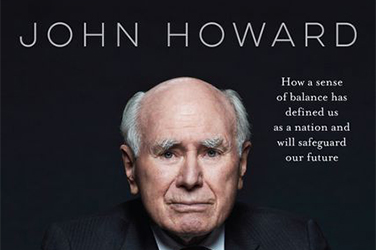
- Free Article: No
- Contents Category: Memoir
- Review Article: Yes
- Article Title: Warm and cuddly
- Article Subtitle: Drawing on Robert Menzies to settle old scores
- Online Only: No
- Custom Highlight Text:
Since his (involuntary) retirement from politics in 2007, John Howard has gone to some lengths to encourage comparisons with Robert Menzies. He authored a lengthy paean to Australia’s longest serving prime minister (2014), appeared in a television series to appraise his leadership and era (2016), and curated an exhibition on him at the Museum of Australian Democracy. And while he does not don the knightly robes that Menzies did on the cover of his volume of essays, The Measure of the Years (1970), Howard does ape Ming’s serene, far-seeing gaze on the dust jacket of this, his third book, A Sense of Balance.
- Article Hero Image (920px wide):

- Article Hero Image Caption: John Howard and Vladimir Putin in Sydney, 2007 (Kremlin Presidential Press and Information Office via Wikimedia Commons)
- Alt Tag (Article Hero Image): John Howard and Vladimir Putin in Sydney, 2007 (Kremlin Presidential Press and Information Office via Wikimedia Commons)
- Featured Image (400px * 250px):

- Alt Tag (Featured Image): Patrick Mullins reviews 'A Sense of Balance' by John Howard
- Book 1 Title: A Sense of Balance
- Book 1 Biblio: HarperCollins, $39.99 hb, 304 pp
- Book 1 Readings Link: booktopia.kh4ffx.net/NKLAPv
But the serenity of the dust jacket is not matched within. Howard has admitted that he was ‘provoked’ to write these essays by the condescension with which political élites greeted the election of Donald Trump and the British vote to leave the European Union (both in 2016). For that reason, one might have expected pages and pages of excoriation of the commentariat and chattering classes. But no. Howard is more troubled about the political parties that presented voters with these choices in the first place. Why, he asks, were the Republicans unable to find a more suitable standard-bearer, and the Tories to understand the mood of their own electorates?
While the United States and United Kingdom provide Howard with his spur, his concern about the state of political parties is domestic. The book’s second essay, on the decline of community-mindedness, is in its latter half a well-aimed arrow at the factionalism and bitter infighting that afflicts the contemporary Liberal Party. Noting that factions did not really exist in the party until the 1980s, Howard traces how a postwar ambivalence toward joining things – whether parties, community organisations, clubs, or more – and the proliferation of political staffing positions since the 1970s have led to the main political parties being dominated by staffers, party officials, and lobbyists with party connections. In the absence of overt ideological objectives, they divide and descend into petty factional squabbles. He argues that this makes the parties inward-looking, less welcoming to newcomers, represented by less talented candidates, and unwilling and unable to engage with and understand the thinking of the community. And while Howard spies this problem in the Labor Party, his comments speak most to the Liberal Party and serve as context for his reflections on the results of the 2022 federal election.
Howard’s analysis of the government’s loss is stinging. He offers a lukewarm defence of Scott Morrison – lauding his leadership during the pandemic, his economic stewardship, and his decisions to take Australia into the AUKUS arrangements and Quad dialogue – but argues that the government mishandled issues around women, did not have the courage to lead any major economic reform, and failed to present a policy agenda for the future. Ministers were faint-hearted and living on legends of the past. The government dilly-dallied and was lily-livered when it should have been lion-hearted. It antagonised its base. Worst of all, it was divided. Factionalism – which Howard wryly dubs ‘the ongoing struggle between what can only be called rival preferment co-operatives’ – has left the party destabilised, its appeal damaged, and now consigned it to the opposition benches.
To rectify this situation, Howard explores what he considers a defining characteristic of Australia: a sense of balance. Howard stresses its importance in the Liberal Party, arguing that it should be a ‘broad church’ spanning conservative and liberal thought, with powers that are balanced between the party’s parliamentary wing and its organisation and members: the first elect the leader and make policy; the latter elect candidates to join that parliamentary wing. Howard does not esteem those models adopted in the United Kingdom and, in Australia, by Labor, where rank-and-file party members have a direct say in the leadership. As he argues, members of parliamentary parties are uniquely placed to observe, assess, and judge their colleagues. This would be more persuasive if the begged question – about the fallibility of those MPs whose poll-induced panic and factionalism has seen this country cycle through repeated leadership ballots since 2010 – were answered.
Elsewhere, Howard’s sense of balance sees him put a finger on the scales. One of the most insistent claims he has made in recent years is that the Coalition extended support to the Hawke and Keating Labor governments (1983–96) on significant policy issues and that, when his government came to power in 1996, Labor failed to repay the favour. The float of the dollar, the admission to Australia of foreign banks, the abolition of interest rate controls, the introduction of HECS – all, he points out, were Labor decisions supported by himself or the Coalition. But when his government tried to enact big-ticket policies, such as the GST and the privatisation of Telstra, Labor refused to lend its support. Thus Howard’s pronouncement that ‘bipartisanship was a one-way street’.
This claim is superficially compelling but spurious on close inspection. The Coalition withheld its support from an array of reforms and policies enacted by Labor under Hawke and Keating, from the introduction of Medicare to that of superannuation. On what Howard declares the biggest economic change of all, the float of the dollar, that support was only extended by Howard himself, then shadow treasurer – not his party, nor his leader. Meanwhile, during the Howard years, the ALP extended bipartisanship on gun control (‘plenty of support’, Howard wrote, in his autobiography), on the treatment of asylum seekers aboard MV Tampa (Labor ‘endorsed’ what the government had done), and more besides. ‘Some commentators,’ Howard writes, ‘nostalgically refer to the 1980s as a golden era when the major parties came together to implement good policy. It was never as warm and cuddly as that.’ No, it wasn’t. Nor were the years that followed.
There are sharp insights in this volume – in addition to those noted above, his essay on China is balanced and genuinely interesting – but also a sense of anecdotal meandering and cursory criticisms, as though Howard, still wearing his knightly armour, is stalking a deserted battlefield and swinging at old foes. Climate change, a republic, a Bill of Rights, critics of the 2003 invasion of Iraq: all receive predictable, glancing blows. Following the more incisive and well-observed cohesion of Howard’s earlier books, this makes for a tired and disjointed read. It is another place where a comparison to Menzies is fitting. Ming’s volumes of memoirs and essays were regarded as puzzling disappointments. Perhaps Howard is now aping his hero a little too closely.


Comments powered by CComment